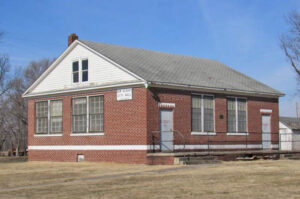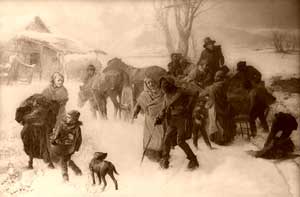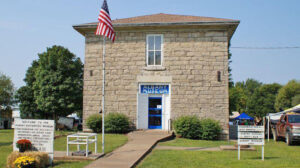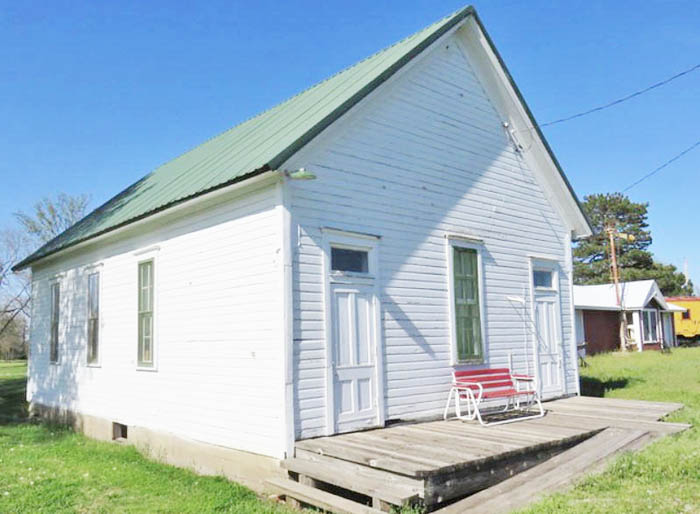Albany, Kansas, was established in 1857 on the Elwood and Marysville Territorial Road in Nemaha County. It was first populated by families from Castle Creek and Painted Post, New York, who named it after the capital of their native state.
Among 15 to 20 families, those principally interested in this movement were Elihu Whittenhall, W.B. Slosson, Edwin Miller, George, John, William Graham, Reverend R.D. Parker, and Archibald Webb.
The first improvement was Edwin Miller’s erection of a two-story clapboard home. The next building was a one-room cottonwood schoolhouse.
A post office was established on August 5, 1858, with John Shumway as postmaster. Emery Lilly, a resident of Albany, picked up mail at Highland, Kansas, and served Hiawatha, Hamlin, Morrill, Fort Plymouth (later Sycamore Springs), Albany, Sabetha, Price, and various other small settlements. Mr. Lilly made deliveries by horseback. Later, the mail was delivered by stagecoach.
Edwin Miller also built a hotel in 1858. That year, a small frame schoolhouse was erected.
On February 1, 1859, abolitionist John Brown spent his last night in Kansas at the house of Edwin Miller. Part of his men were quartered with Elihu Whittenhall and some at George Graham’s and W. B. Slosson’s. From Albany, they passed through Nebraska, Iowa, Illinois, and Michigan, leaving the United States at Detroit and proceeding to Canada, where he organized the Southern movement, which resulted in his death.
Archibald Webb laid out the town of Albany in 1859. That year, Edwin Miller, fearing the title to his land was not clear, moved his two-story cottonwood structure to Sabetha. It was placed on long logs and pulled by a sled with 40 yokes of oxen.
From the organization of the Underground Railroad in Topeka, Kansas, in 1857 until slavery was abolished, Albany served as a station on the line. Fugitive slaves were secreted by day and taken by “conductors” at night to the next station. Slaves were hidden in the hay of the livery stables near the sawmill, in the woodshed behind the Albany store, or in a cave above the Pony Creek Ford. From Albany, they went north to Salem, Nebraska, then to Fisher’s Mill on the Nemaha River, and then to Nebraska City, where they forded the river into Iowa.
One of the fugitive slaves, “Aunt Rachel” Holden, with her family of five children, escaped as far as Albany in 1862 and decided to remain. A small house was built for them, and they were guarded by a patrol until the end of the Civil War. Her oldest son fought in the Union Army and was killed. The others went to the Albany School and were members of the Congregational Church until 1865 when they moved to White Cloud.
In 1860, Elihu Whittenhall constructed a four-room residence of black walnut lumber to replace his log cabin. The same year, Moses Stevens, a merchant of Brooklyn, New York, built the first store building.
Later, Moses Stevens sold his store to William and Samuel Slosson, who began operating the store in December 1861, with a stock of goods bought from Free State men in Salem, Nebraska, who thought the goods would be confiscated by border ruffians if left in Salem. The store regularly employed five or six clerks. It also served as a community center.
In 1865, a permanent two-story school building was constructed. Native limestone was quarried nearby and used throughout the construction. Members of the Congregational Church agreed to pay for a second floor if they could hold church there on Sundays and Wednesday evenings. When complete, the first floor was used as a grammar school and provided space for 60 students and their teachers. The second floor was used as an academy, and an average of 70 students from Kansas, Nebraska, and Missouri attended. A hotel and boarding house were opened to accommodate the students.
That year, 40 acres of land were transferred from I.D. Sammons and his wife were to be buried at the First Congregational Church for cemetery purposes only. The Montrose Cemetery has been used for burials since 1862.
Although Albany was never incorporated, it became a flourishing trade and cultural center, the largest between Seneca and Hiawatha.
In 1870, the St. Joseph and Denver Railroad officials spent weeks surveying a possible route through the hills and timbered valleys in the Albany area. Since feasible grades could not be made, plans were made for the railroad to go to Sabetha, and Albany immediately began to fade upon its arrival. That year, the Slosson brothers moved the store to Sabetha and named it “That Old House.” Many settlers followed and helped form the town of Sabetha. The hotel was moved to Sabetha in 1871.
The Albany post office closed on July 17, 1882, and the town’s schoolhouse was almost all that remained.
The school continued in Albany until 1962, when the students were furnished transportation to Sabetha schools.
In July 1965, the newly formed Albany Historical Society acquired the school and grounds. Members donated most of the labor to restore the building. First-floor displays consist of student and teacher desks, blackboards, and two pianos with a divider down the center of the large room. On the other side of the room are many items not connected to the school, but many of historical value. The second floor displays the original church pews, a pump organ, an old-time kitchen, a bedroom, a parlor, a bath, and a country store.
Following renovation work, the school is now maintained as a museum. Several other buildings of local historic interest have also been relocated on the school grounds, one-half mile west of US-75, two miles north of Sabetha at 2441 204th Road.
©Kathy Alexander/Legends of Kansas, updated July 2025.
Also See:
Extinct Towns of Nemaha County
Sources:
Blackmar, Frank W.; Kansas: A Cyclopedia of State History, Vol I; Standard Publishing Company, Chicago, IL 1912.
City of Sabetha
Cutler, William G; History of Kansas; A. T. Andreas, Chicago, IL, 1883.




